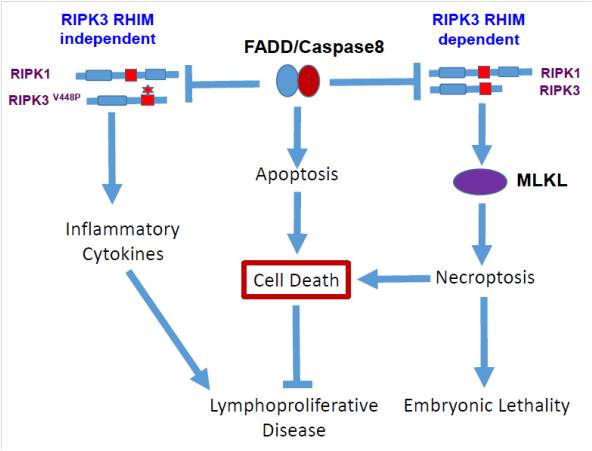
Receptor-interacting protein kinase 3 (RIPK3) is a member of the receptor-interacting protein (RIP) family of serine/threonine kinases, which contains an N-terminal kinase domain and a C-terminal RIP homotypic interaction motif (RHIM).
Through RHIM-mediated protein interaction, RIPK3 forms a necrosome complex with RIPK1, and this complex is required for activation of downstream effector protein MLKL and execution of necroptosis. In addition to the mediator of necroptosis, RIPK3 can also regulate apoptosis and inflammatory response. However, the relative contribution of RIPK3 RHIM in physiological function remain not well understood.
In a study published in Cell Reports, a group led by Dr. ZHANG Haibing from the Shanghai Institute of Nutrition and Health (SINH) of the Chinese Academy of Sciences revealed that RIPK3 RHIM is required for both apoptosis and necroptosis through RHIM-RHIM mediated interaction. They also demonstrated that RIPK3 has a critical function in regulating lymphoproliferative disease in the absence of Fadd and this function was independent of RIPK3 RHIM and MLKL.
The researchers generated Ripk3V448P/V448P knock-in mice by mutating the critical residue of RHIM at position 448 Valine to Proline.
In contrast to mice expressing truncated RIPK3 with RHIM deleted showed much lower level expression of RIPK3 than wild-type (WT) mice, RIPK3V448P expression is comparable to WT RIPK3. Given that RIPK3 kinase inactive mutants mouse model including RIPK3-K51A and RIPK3-D161N also expressed much lower level of RIPK3 compared to WT mice, the Ripk3V448P mutant mouse could provide a novel model to explore functions of distinct domains of RIPK3 without affecting its expression or stability.
Unexpectedly, although Ripk3V448P/V448P expectedly prevent embryonic lethality in Fadd deficiency mice, similar as Mlkl-/-Fadd-/- mice, Ripk3V448P/V448PFadd-/- mice displayed a more severe lymphoproliferative disease with a marked increase CD3+B220+ abnormal T lymphocyte than Ripk3-/-Fadd-/- mice. More importantly, these inflammatory morbidities in Ripk3V448P/V448PFadd-/- mice were profoundly inhibited by additional deletion of Ripk1.
Furthermore, the combined Fadd deletion with homozygous mutant or heterozygous mutant of RIPK3 V448P prevents the perinatal lethality of Ripk1-deficient mice, suggesting that RIPK1 regulates a RIPK3, but not RIPK3 RHIM, mediating inflammatory process.
These findings revealed previously unappreciated physiological functions of RHIM of RIPK3 in regulating RIPK1 dependent cell death and lymphoproliferative disease. This study provides a new insight into the function of RIPK3 regulating necroptosis, apoptosis and inflammatory response.

Schematic representation of the RIPK3 RHIM in RIPK1 dependent cell death and lymphoproliferative disease. (Image by Dr. ZHANG Haibing's group)

86-10-68597521 (day)
86-10-68597289 (night)

86-10-68511095 (day)
86-10-68512458 (night)

cas_en@cas.cn

52 Sanlihe Rd., Xicheng District,
Beijing, China (100864)

